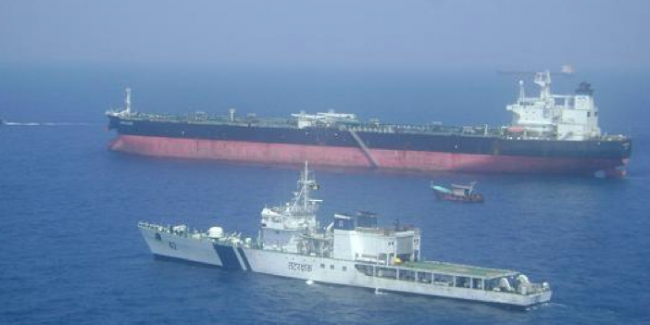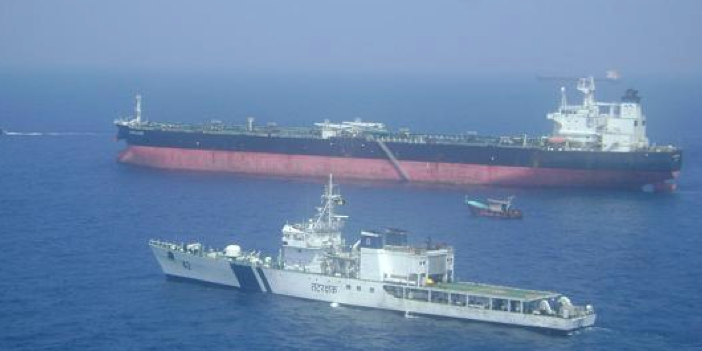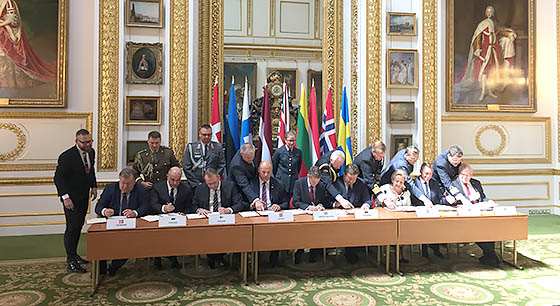Off India, the blunder turns into a diplomatic incident (Maj5)

(BRUSSELS2) Six Italian soldiers and the captain of the Enrica Lexie were interviewed on Sunday by the Indian police in the state of Kerala and two of them remanded in custody after the incident which took place off the Indian coasts, last Wednesday (February 15).
The San Marco regime soldiers were part of the protection teams on board the Enrica Lexie, an oil tanker flying the Italian flag, which was located nearby off Alappuzha, a few miles from the coast (12 miles or 33 miles according to the sources), when they saw a suspicious boat which was very close to them and appeared threatening.
Two dead, two fishermen
Finally a shot on goal hit the fishing boat named St. Anthony. Result: two deaths... two fishermen in fact. The suspect vessel was, in fact, not a pirate skiff but an Indian dhow, of 11 tuna fishermen. Informed, the Indian authorities opened an investigation and dispatched a team of investigators from the Kerala police to the scene. The coast guard ships - the Lakshmibhai and then the Samar - then escorted the Italian ship to the nearest port of Kochi. The captains of the two boats concerned were heard by the police. The captain of the Enrica Lexie has agreed to cooperate fully with the Indian investigation. Sunday, the investigation took a new step with the hearing of the captain and the six soldiers of San Marco. Two soldiers - perpetrators of the shootings - would be particularly incriminated; they were picked up from the guest house where they were staying, incarcerated and could be charged with murder.
Significant discrepancies in the versions
Everything seems to incriminate the Italian military. " We were fishing, when the guards of the Italian ship opened fire, for no reason - says dhow owner Freddie Louis - killing both fishermen instantly “, as reported by the Indian press. Jalastein and Ajesh Binki were 45, the other 25. But on what happened, when and where, the versions differ widely depending on whether one listens to Rome or New Delhi. We can even say that nothing actually matches.
First divergence, the hour. Between the Indian version and the Italian version, there is a two hour difference; the Italians sounding the alarm at 11:00 a.m. (16 p.m. local time) while the Indians place the incident 2 hours later (18 p.m. local time). Weird. But the Archbishop of Trivandrum (the capital of Kerala) confirmed, according to asia news, the version of the fishermen who were Catholic. " The accident happened at 16:30 p.m. (local time). (...) At this time, the men were resting, because they fish at night there. The Italian vessel was within India's territorial waters. Binki, the helmsman, was on the belvedere. He was struck in the face below his left eye and died instantly. Jalastein stood up and was shot in the chest. The other nine woke up and gave the alarm to the coastguards. (...) THE fishing boat returned to port at 22:30 p.m. Reaching international waters from the coast takes more than a day. ».
Second difference, the place. Satellite data - estimates the Italian Foreign Minister - show that the ship flying the Italian flag was in international waters, 33 miles from the coast; the competent judge should be Italian. For the Indians, the facts happened against an Indian ship in Indian territorial waters 12-13 miles from the coast.
Third discrepancy, and the most important, the nature of the shots. About twenty shots were fired according to the Indians, several of which hit the keel of the St. Anthony and four the two fishermen. Italian side, any other version. The servicemen on board the "Lexie" saw the ship approaching and first fired several warning bursts in the air and in the water, but without touching it, according to the report of the commander of the military transmitted to Rome,: the first takes place when the boat was at 500 meters, the second at 300 meters and the third at 100 meters. And nobody was affected explains the head of the military, photos in support. There were not 11 people on board the boat but about 5 "pirates", some of whom were armed and who fled after the shooting. Explanation according to the Italians: it would not be the same incident or the same boat on which the soldiers would have fired and the fishermen's boat which could have been hit by "real" pirates. We should know more with the ballistics analysis. For the moment, " the weapons used were kept under lock and key by ship managers in the ship itself ". Indian police should get a search warrant from the court for “ take possession of the weapon said Kochi Commissioner Ajith Kumar, according to Indian news agency IANS.
Another point of contention. The Italians accuse the Indians of luring the ship into a trap to arrest them. The Indians allegedly only wanted to visit the ship. In fact, they seized the soldiers. Apparently the Italian military and the captain of the "Lexie" were not of the same opinion. The captain wanted to reach the port as the Indians ordered him, which the soldiers refused.
Fifth discrepancy. The Italians argue the immunity enjoyed by the Italian military, as state forces. La Farnesina (the Italian foreign ministry) pointed this out: “The presence of military personnel on merchant ships is regulated by a specific Italian law which responds to the provisions of the United Nations resolutions on the fight against piracy. In this context, the military organs of the Italian State enjoy immunity ».
A "textbook case" of questioning liability
(Comment) The risk was known. Since the beginning of anti-piracy operations, the presence of armed guards on board ships could lead to a lawsuit in the event of slippage. Already in the past, several cases of "blunders" had taken place in the Indian Ocean. In some cases, moreover, the Indian Navy was involved. But so far no legal action has been taken. The fact that it was Indian fishermen off the Indian coast who died is indeed a game-changer both politically and legally. (NB: in a way, the incident remains for the moment limited to the diplomatic level. Imagine that instead of Indian fishermen, it would have Iranian sailors who were thus the object of fire... the incident could then have taken on a much more important dimension, in international and military terms).
We are now faced with the first "textbook case" of the official questioning of the guards of merchant ships for their actions. It will be necessary to determine exactly the applicable law, and in particular to examine whether the fact occurred in territorial waters. This will be one of the discussions between the Indians and the Italians, the figures not agreeing (12 or 40 miles from the coast). The fact that it is soldiers who are the perpetrators of the shots complicates both the deal at the diplomatic and political level but also simplifies it. It is a state-to-state negotiation that will take place. The Italian consul in Mombai assists his compatriots; and Italian Prime Minister Mario Monti is kept informed of the latest developments in this case.
In any case, the calling into question of the responsibility of the captain, the owner of the ship and the Italian State may seem very clear if one reads the international conventions, in particular on the law of the sea. But we are evolving here in a legal context, more than vague, in particular on the nature of the responsibility of each of the stakeholders, and ultimately of the military or private guards. Until now, we hid our heads in the sand. This case should have significant repercussions on the way in which operations are carried out and lead maritime and political circles not only to reflect but to write an addendum to these conventions. Whatever the outcome of this affair, it seems important, in fact, to establish much more clearly the chain of responsibility.
(*) Convention on the Law of the Sea - extracts. Article 95 - Immunity of warships on the high seas "Warships on the high seas shall enjoy complete immunity from the jurisdiction of any State other than the flag State."(...) Article 97 - Criminal jurisdiction in matters of collision or in respect of any other incident of maritime navigation. "1. In the event of a collision or any other incident of maritime navigation on the high seas which engages the criminal or disciplinary liability of the master or any other member of the ship's personnel, no criminal or disciplinary proceedings may be instituted except before the judicial or administrative authorities either of the flag State or of the State of which the person concerned is a national. 2. In disciplinary matters, the State which issued a certificate of command or a certificate of competency or permit is alone competent to pronounce, by respecting the legal means, the withdrawal of these titles, even if the holder does not have the nationality of that state. 3. The seizure or detention of the vessel may not be ordered, even in the execution of evidence, by authorities other than that of the flag State."
(Updated: Sunday evening with the first elements of the investigation; Monday a more detailed explanation on the discrepancies in the version, the testimony of the Archbishop of Trivandrum and the text of the convention of the law of the sea; Wednesday with details on warning bursts).
Read also:




French EPEs have a strict engagement procedure (Radio, signals, evasive maneuvers, air shooting, water shooting, shooting at goal).
it seems strange to me that a shot on goal could have been triggered “dry” by a Western team…
We absolutely do not hide our heads in the sand, or in anything else.
The framework in the matter could not be clearer. It is that of self-defense. There can be no question of initiative shooting, other than in time of war, including for soldiers. Even in UN operations, the most frequent framework (and by far) retained is that of self-defence.
It is therefore a question of precisely identifying a threat, authenticating it and responding to it proportionately. Which obviously has absolutely not been done. The responsibility of the shooters is therefore total.
The question that remains, however, is the legality of their place on board. But that's another subject. It is good not to mix them hastily and abusively to maintain consistency in the debate.
"So it's about precisely identifying a threat, authenticating it and responding to it proportionately."
Isn't that more difficult to do in real conditions than in theory?